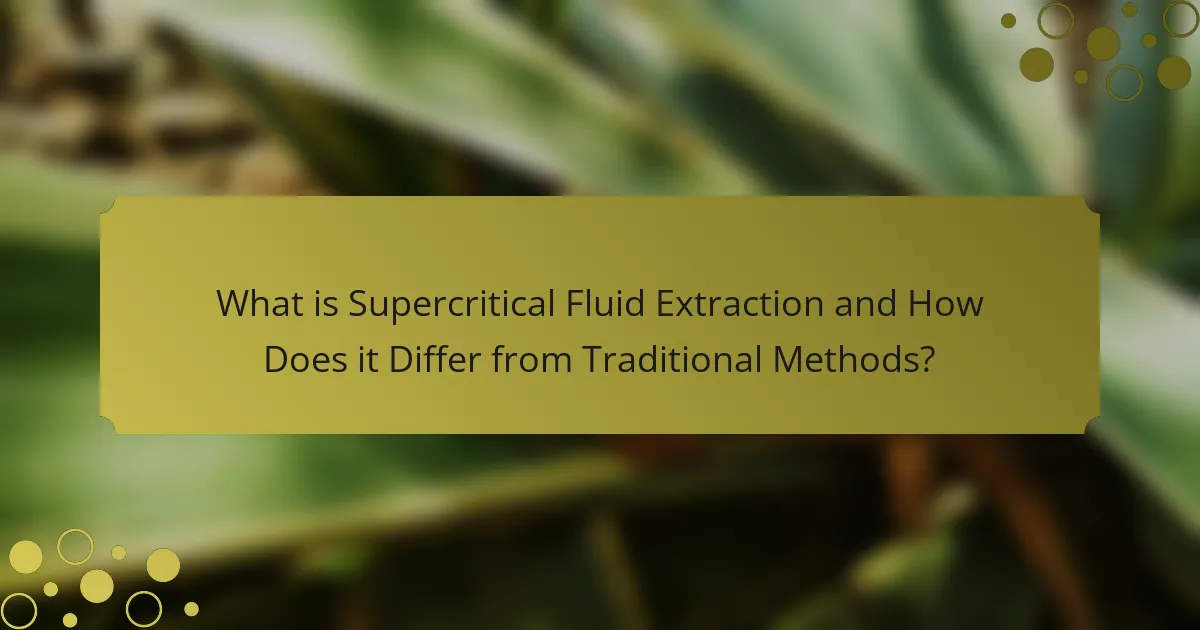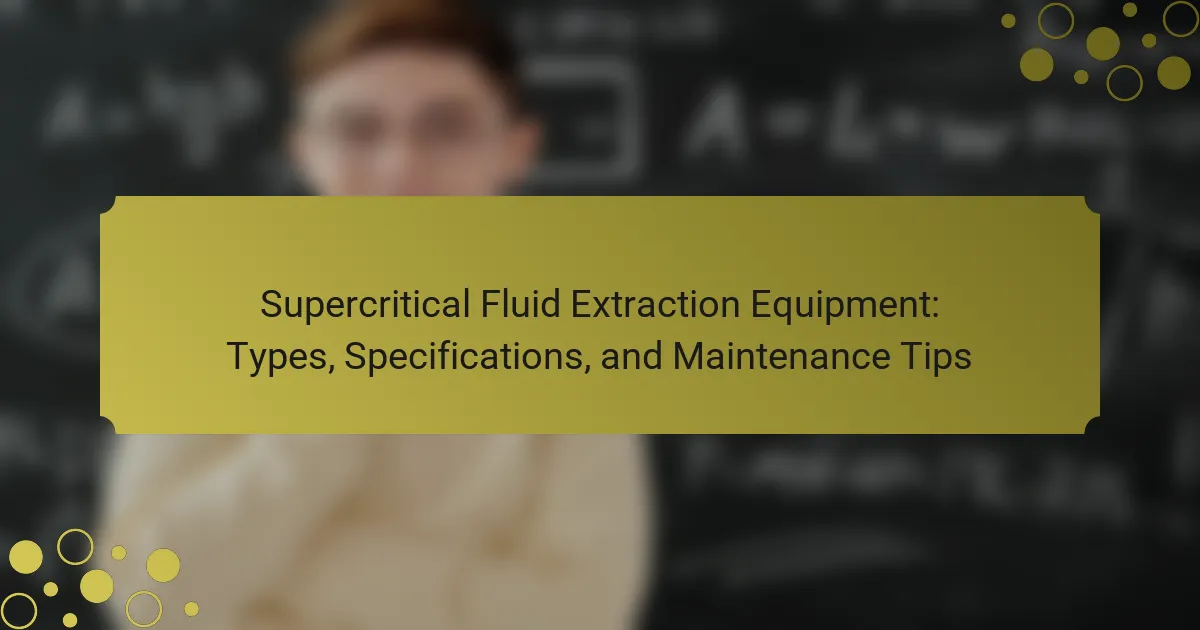Supercritical Fluid Extraction (SFE) is a technique that utilizes supercritical fluids, primarily carbon dioxide, as solvents to efficiently extract compounds from various materials. This method operates at high pressures and moderate temperatures, reducing thermal degradation compared to traditional extraction methods that often use organic solvents and higher temperatures. While SFE offers advantages such as environmental friendliness and enhanced selectivity, it also has limitations, including high equipment costs, specialized operational knowledge, and potential inefficiencies for certain compounds. The article explores the comparisons between SFE and traditional methods, highlighting their respective benefits, applications, and future trends in extraction technology.

What is Supercritical Fluid Extraction and How Does it Differ from Traditional Methods?
Supercritical Fluid Extraction (SFE) is a technique that uses supercritical fluids as solvents to extract compounds from various materials. Supercritical fluids, typically carbon dioxide, exhibit unique properties that allow for efficient extraction. In contrast to traditional methods, SFE operates at high pressures and moderate temperatures, which minimizes thermal degradation of sensitive compounds. Traditional extraction methods often rely on organic solvents and higher temperatures, leading to longer extraction times and potential solvent residues. SFE is more environmentally friendly, as it reduces the use of harmful solvents. Additionally, the selectivity of supercritical fluids can be fine-tuned by adjusting pressure and temperature, enhancing the extraction of desired compounds. This adaptability is not commonly found in traditional methods, making SFE a more versatile option for various applications.
How does supercritical fluid extraction work?
Supercritical fluid extraction (SFE) works by utilizing a supercritical fluid, typically carbon dioxide, to extract compounds from a solid or liquid matrix. In this process, carbon dioxide is heated and pressurized beyond its critical point, resulting in unique properties that exhibit both gas and liquid characteristics. The supercritical CO2 then permeates the material, dissolving the target compounds.
As a solvent, supercritical CO2 selectively extracts specific components based on their solubility. This method is efficient and environmentally friendly, as it avoids the use of harmful organic solvents. Research indicates that SFE can yield higher purity extracts compared to traditional methods like solvent extraction or steam distillation. This is due to the precise control over temperature and pressure, allowing for tailored extraction conditions.
What are the key components of supercritical fluid extraction?
The key components of supercritical fluid extraction (SFE) include the supercritical fluid, extraction chamber, and separation system. The supercritical fluid, often carbon dioxide, acts as the solvent. It possesses unique properties that enhance solubility and selectivity. The extraction chamber facilitates the contact between the supercritical fluid and the material being extracted. The separation system allows for the collection of extracted compounds after the extraction process. These components work together to efficiently extract desired compounds while minimizing thermal degradation.
What are the physical and chemical principles behind supercritical fluid extraction?
Supercritical fluid extraction (SFE) relies on the unique properties of supercritical fluids, primarily carbon dioxide. A supercritical fluid exists above its critical temperature and pressure, exhibiting properties of both liquids and gases. This state allows for enhanced solvation and mass transfer capabilities.
In SFE, the solubility of compounds can be adjusted by varying pressure and temperature. Increased pressure typically enhances solubility, while elevated temperature can improve extraction rates. The ability to fine-tune these parameters enables selective extraction of desired compounds.
The chemical interactions between the supercritical fluid and the target compounds are crucial. Non-polar compounds are effectively extracted using carbon dioxide, as it is non-toxic and leaves no residual solvent. The efficiency of SFE is supported by its ability to extract thermally sensitive compounds without degradation.
Research has shown that SFE can yield higher extraction efficiencies compared to traditional methods, such as solvent extraction. For instance, a study published in the Journal of Supercritical Fluids highlighted that SFE can achieve extraction yields of up to 90% for certain botanical extracts. These principles underscore the effectiveness and versatility of supercritical fluid extraction in various applications.
What are the main advantages of supercritical fluid extraction over traditional methods?
Supercritical fluid extraction (SFE) offers several advantages over traditional methods. SFE uses supercritical fluids, typically carbon dioxide, which have unique solvent properties. This method results in higher extraction efficiency compared to solvents used in traditional methods. SFE operates at lower temperatures, preserving heat-sensitive compounds. It also minimizes the use of harmful organic solvents, making it more environmentally friendly. Additionally, SFE allows for selective extraction, targeting specific compounds without unwanted byproducts. Studies show that SFE can achieve higher yields in less time than traditional methods, enhancing productivity. Overall, these advantages make SFE a preferred choice in various industries, including pharmaceuticals and food processing.
How does supercritical fluid extraction enhance extraction efficiency?
Supercritical fluid extraction enhances extraction efficiency by utilizing supercritical fluids, typically carbon dioxide, as solvents. Supercritical fluids possess unique properties, such as low viscosity and high diffusivity. These characteristics allow them to penetrate materials more effectively than traditional solvents.
Additionally, supercritical fluids can be easily manipulated by adjusting temperature and pressure. This flexibility enables selective extraction of specific compounds, improving yield and purity. Studies have shown that supercritical fluid extraction can achieve higher extraction rates compared to conventional methods. For instance, research indicates that extraction efficiency can increase by up to 90% in certain applications.
Overall, the combination of superior solvent properties and adjustable extraction conditions makes supercritical fluid extraction a more efficient method for obtaining desired compounds.
What environmental benefits does supercritical fluid extraction provide?
Supercritical fluid extraction (SFE) offers significant environmental benefits. SFE uses carbon dioxide as a solvent, which is non-toxic and environmentally friendly. This method reduces the need for harmful organic solvents that can pollute air and water. SFE is energy-efficient, often requiring lower temperatures and pressures compared to traditional extraction methods. This results in lower greenhouse gas emissions. Additionally, SFE generates less waste, as it can selectively extract desired compounds without leaving behind harmful residues. Studies have shown that SFE can achieve high extraction efficiency while minimizing environmental impact.
In which industries is supercritical fluid extraction predominantly used?
Supercritical fluid extraction is predominantly used in the food, pharmaceutical, and cosmetic industries. In the food industry, it extracts flavors, fragrances, and essential oils without harmful solvents. The pharmaceutical industry utilizes it for isolating active compounds from plants and for drug formulation. In cosmetics, supercritical fluid extraction helps in obtaining natural ingredients for skincare products. This method is favored for its efficiency and ability to preserve the quality of sensitive compounds.
How is supercritical fluid extraction applied in the food industry?
Supercritical fluid extraction (SFE) is applied in the food industry to extract flavors, oils, and nutrients from raw materials. SFE uses supercritical carbon dioxide, which acts as a solvent to selectively dissolve compounds. This method is efficient and environmentally friendly. It operates at lower temperatures, preserving heat-sensitive components. SFE also reduces solvent residues compared to traditional extraction methods. The food industry uses SFE for producing essential oils, spices, and natural food additives. Research shows that SFE can yield higher quality extracts with enhanced flavor profiles. Studies indicate that SFE extracts contain more bioactive compounds than those obtained through conventional methods.
What role does supercritical fluid extraction play in the pharmaceutical sector?
Supercritical fluid extraction (SFE) serves a crucial role in the pharmaceutical sector by efficiently isolating active compounds. SFE utilizes supercritical fluids, typically carbon dioxide, to extract bioactive substances from plant materials. This method is favored for its ability to preserve the integrity of sensitive compounds. It operates at lower temperatures compared to traditional extraction methods. Consequently, SFE minimizes thermal degradation of heat-sensitive pharmaceuticals.
Research indicates that SFE can enhance extraction yields, making it more effective than conventional techniques. A study published in the Journal of Pharmaceutical Sciences highlighted that SFE achieved higher purity levels in extracted compounds. Additionally, SFE is environmentally friendly, producing fewer solvents and waste. This aligns with the pharmaceutical industry’s increasing focus on sustainability. Overall, SFE enhances efficiency, purity, and environmental sustainability in pharmaceutical applications.

What are the limitations of supercritical fluid extraction compared to traditional methods?
Supercritical fluid extraction (SFE) has several limitations compared to traditional methods. One limitation is the high cost of equipment required for SFE. Traditional methods, such as solvent extraction, typically use less expensive materials. Another limitation is the need for specialized knowledge to operate SFE systems effectively. This contrasts with traditional methods, which may be more straightforward.
Additionally, SFE may have lower extraction efficiencies for certain compounds. Some compounds are better extracted using polar solvents in traditional methods. Temperature and pressure conditions in SFE can also limit the types of materials that can be processed. Traditional methods often allow for a wider range of operational conditions.
Moreover, SFE may not be suitable for heat-sensitive compounds, as the process involves high temperatures and pressures. Traditional methods can often be adjusted to minimize thermal degradation. Finally, scalability can be an issue with SFE, as scaling up the process may lead to inconsistencies. Traditional methods often have established protocols for larger scale production.
What challenges are associated with the implementation of supercritical fluid extraction?
The implementation of supercritical fluid extraction (SFE) faces several challenges. High equipment costs are a significant barrier for many organizations. The technology requires specialized machinery to maintain high pressure and temperature. This can lead to increased capital investment and operational expenses. Additionally, the extraction process can be sensitive to variations in temperature and pressure. This sensitivity may result in inconsistent product quality. Another challenge is the need for skilled personnel to operate and maintain the equipment. The complexity of the process demands a higher level of expertise compared to traditional methods. Furthermore, the selection of suitable solvents can be limited. Not all compounds are effectively extracted with supercritical fluids, which may restrict application scope. Lastly, regulatory hurdles exist regarding the use of certain solvents in food and pharmaceutical industries. These challenges can hinder the widespread adoption of SFE technology.
How does the cost of supercritical fluid extraction compare to traditional methods?
Supercritical fluid extraction (SFE) generally has higher initial costs compared to traditional extraction methods. Traditional methods often use solvents that are less expensive and require simpler equipment. SFE requires specialized machinery and higher energy input, which increases its overall cost. However, SFE can yield higher purity and efficiency, potentially lowering long-term costs by reducing the need for further purification. According to a study by C. A. M. Van Dyk et al. in “Journal of Supercritical Fluids,” SFE can be more cost-effective in large-scale operations due to its efficiency and reduced solvent usage.
What technical limitations might users face with supercritical fluid extraction?
Users may face several technical limitations with supercritical fluid extraction (SFE). High operational costs are a primary concern. The equipment required for SFE is expensive and requires significant maintenance. Users also encounter challenges with the solubility of certain compounds. Not all substances dissolve effectively in supercritical fluids. Process optimization can be complex and requires specialized knowledge. Additionally, temperature and pressure control can be difficult to maintain consistently. This can lead to variability in extraction efficiency. Finally, scale-up from laboratory to industrial levels presents logistical challenges. These limitations can hinder widespread adoption of SFE in various applications.
How can traditional extraction methods still be relevant in certain applications?
Traditional extraction methods remain relevant due to their cost-effectiveness and simplicity. These methods, such as maceration and distillation, are widely accessible and do not require specialized equipment. Many industries, including food and herbal, still rely on these techniques for their effectiveness in extracting flavors and bioactive compounds. For example, steam distillation is a common method for producing essential oils. It effectively captures volatile compounds without the need for complex technology. Additionally, traditional methods often yield high-quality extracts that meet specific regulatory standards. Their established processes and historical usage provide a reliable framework for quality control. In many cases, traditional methods can be more sustainable and environmentally friendly compared to newer techniques.
What are the benefits of using traditional extraction methods?
Traditional extraction methods offer several benefits. They are often more cost-effective compared to advanced techniques. Many traditional methods require less specialized equipment. This accessibility makes them suitable for small-scale operations. Additionally, traditional methods can preserve the integrity of sensitive compounds. They often utilize natural solvents, which can be safer for the environment. The simplicity of these methods allows for easier replication in various settings. Historical usage demonstrates their effectiveness across multiple industries, including food and herbal extracts.
In which scenarios do traditional methods outperform supercritical fluid extraction?
Traditional methods outperform supercritical fluid extraction in scenarios involving low-cost or small-scale extractions. They are more accessible for labs with limited budgets. Traditional methods, such as solvent extraction, can be more effective for specific compounds that do not extract well with supercritical fluids. In cases where high temperatures are detrimental, traditional methods are preferable as they often operate at lower temperatures. Additionally, traditional methods can be more suitable for large volumes of material. They also allow for easier recovery of solvents, which can be critical in some applications. Furthermore, traditional methods may be more efficient in extracting certain polar compounds that supercritical fluids struggle with.

What future trends can we expect in supercritical fluid extraction technology?
Future trends in supercritical fluid extraction technology include increased automation and integration with artificial intelligence. These advancements will enhance process efficiency and precision. Additionally, there is a growing focus on the extraction of high-value compounds from natural sources. Research indicates a shift towards using alternative solvents to reduce environmental impact. The industry is also moving towards miniaturization of extraction systems for on-site applications. Enhanced safety measures and energy efficiency are becoming priorities in equipment design. Overall, these trends aim to improve sustainability and economic viability in extraction processes.
How is technology evolving in the field of supercritical fluid extraction?
Technology in supercritical fluid extraction (SFE) is evolving through advancements in equipment, process optimization, and integration with other technologies. New high-pressure pumps and automated systems enhance efficiency and reproducibility. Improved software algorithms enable precise control over extraction parameters. Additionally, the use of alternative solvents is being explored to expand application ranges. Research indicates that these innovations lead to better yield and purity of extracted compounds. For instance, studies have shown that combining SFE with ultrasound can further increase extraction efficiency. These developments position SFE as a competitive alternative to traditional extraction methods.
What innovations are being developed to improve supercritical fluid extraction processes?
Innovations in supercritical fluid extraction (SFE) processes include the development of advanced solvents and enhanced extraction techniques. Researchers are exploring the use of alternative solvents, such as ionic liquids, which can improve selectivity and efficiency. Additionally, the integration of ultrasound and microwave-assisted extraction methods is being investigated to increase extraction rates and yield.
Real-time monitoring technologies are also being developed to optimize extraction parameters dynamically. These innovations aim to reduce extraction times and energy consumption. Furthermore, advancements in equipment design, such as the use of modular systems, allow for greater flexibility and scalability in SFE applications.
The combination of these innovations is expected to enhance the overall effectiveness of supercritical fluid extraction in various industries, including pharmaceuticals and food processing.
What best practices should be followed when choosing between supercritical fluid extraction and traditional methods?
When choosing between supercritical fluid extraction and traditional methods, consider the specific application requirements. Supercritical fluid extraction is often preferred for its efficiency and ability to extract high-quality compounds. Traditional methods may be more suitable for lower-cost operations or when specialized equipment for supercritical extraction is unavailable. Evaluate the solubility of target compounds; supercritical fluids can dissolve a wider range of substances. Analyze the extraction time; supercritical methods typically offer faster results. Assess the environmental impact; supercritical extraction often uses less organic solvent, making it more eco-friendly. Finally, consider scalability; supercritical fluid extraction can be more easily scaled for larger production needs.
How can one determine the right extraction method for specific applications?
To determine the right extraction method for specific applications, one must consider the properties of the target compounds. The solubility of compounds in different solvents is crucial. For example, supercritical fluid extraction (SFE) is effective for non-polar compounds. Conversely, traditional methods like solvent extraction may be better for polar substances.
The desired purity and yield also influence the choice of method. SFE typically yields higher purity extracts compared to traditional methods. Additionally, the extraction time and temperature are important factors. SFE operates at lower temperatures, preserving heat-sensitive compounds.
Cost and scalability should also be assessed. Traditional methods are often less expensive but may not be scalable for large production. Finally, regulatory considerations and safety profiles of solvents are essential. SFE uses carbon dioxide, which is generally recognized as safe.
By evaluating these factors, one can determine the most suitable extraction method for their specific application.
What factors should be considered when evaluating extraction method efficiency?
Extraction method efficiency is evaluated based on several key factors. These factors include yield, selectivity, and extraction time. Yield refers to the amount of desired product obtained from the extraction process. High yield indicates an efficient method. Selectivity measures the method’s ability to isolate specific compounds without unwanted substances. Faster extraction times contribute to overall efficiency, reducing operational costs. Additionally, solvent usage and environmental impact are crucial. Efficient methods minimize solvent use and reduce waste. Cost-effectiveness is also important, as it assesses the economic viability of the extraction method. Finally, scalability determines whether the method can be effectively applied in larger production settings. These factors collectively inform the evaluation of extraction method efficiency.
Supercritical Fluid Extraction (SFE) is a modern extraction technique utilizing supercritical fluids, primarily carbon dioxide, to efficiently extract compounds from various materials. This article compares SFE with traditional extraction methods, highlighting its advantages such as higher extraction efficiency, preservation of heat-sensitive compounds, and reduced environmental impact. Key components of SFE, the underlying physical and chemical principles, and its applications in industries like food, pharmaceuticals, and cosmetics are discussed. Additionally, the article addresses the limitations of SFE, challenges in its implementation, and future trends in extraction technology, providing a comprehensive overview of the extraction landscape.



